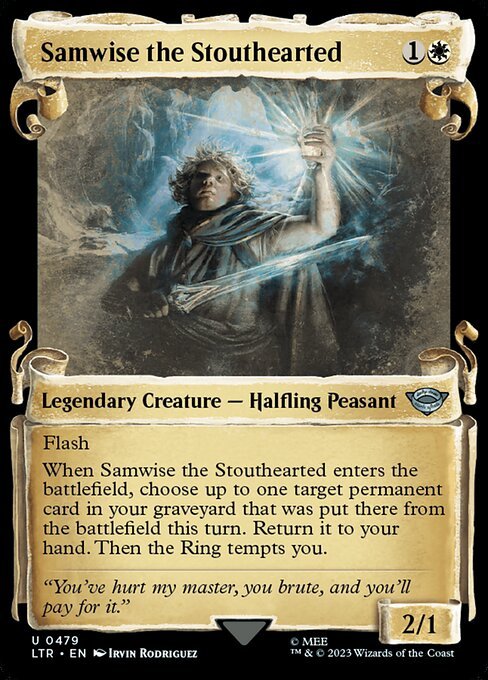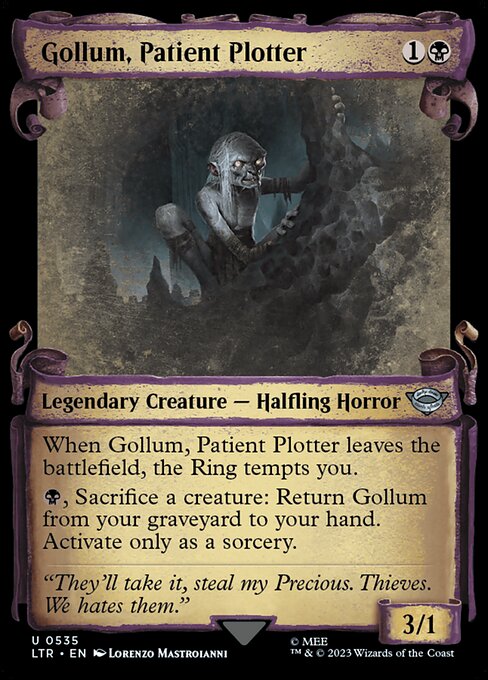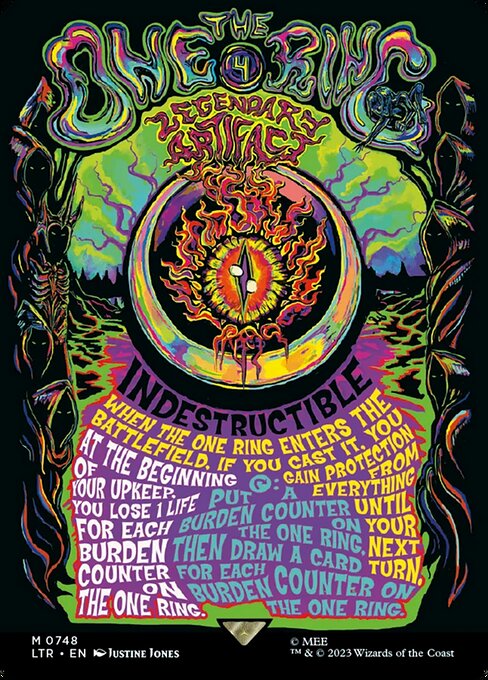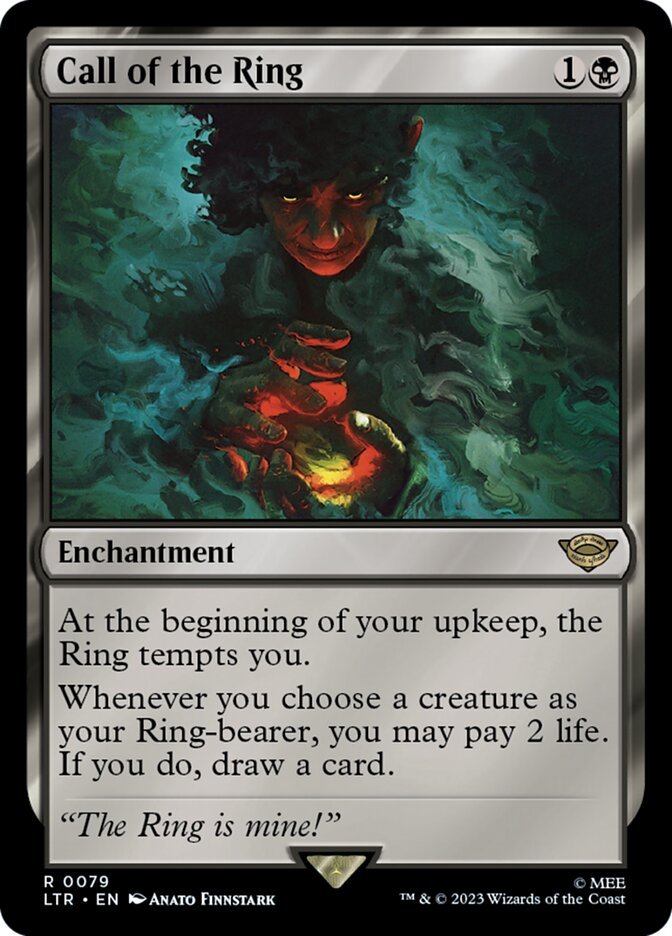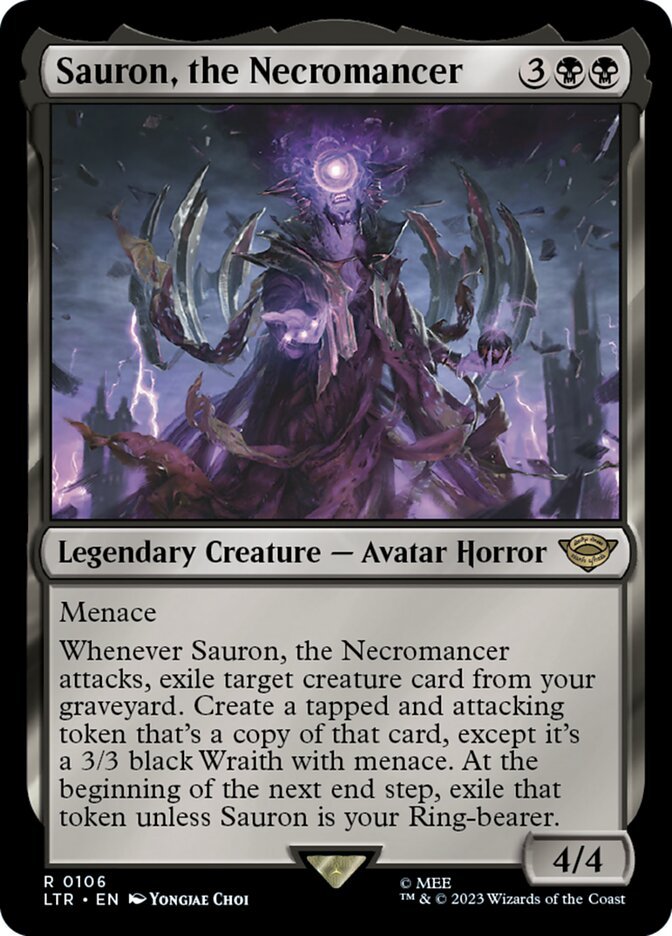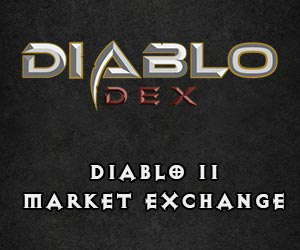"The Ring Tempts You" Is All Upside - Here's How It Works

The MagicCon Minneapolis Preview Panel gave us quite a bit of MTG news yesterday. "Lord of the Rings: Tales of Middle Earth" was one of the sets covered, and we learned a great deal about how "The Ring Tempts You" works. We'd previously seen it mentioned on a few early spoilers, but there was no indication of how it affected gameplay. Well, now we know. And it's excellent. So, without further ado, let's see how ring tempting works in MTG and what makes it good.
The Ring
Whenever a card or ability calls for the ring to tempt you for the first time, you'll get an emblem named "The Ring" (which you can see below) and choose a creature you control to be your ring bearer. The emblem has four progressions; each time the ring tempts you, you gain the next ability in addition to the ones before it, and you may choose a new ring bearer if you want. If you don't, the original creature retains the ring.
Before I get further into this, I want to clarify a few things. First, you'll still create the emblem if you don't have a creature in play when the ring tempts you. If you do have one or more creatures in play when the ring tempts you, you have to choose one of them. Furthermore, each player may have only one emblem and one ring-bearing creature at a time.
You May Also Like: Commander Masters Precon Spoilers - All Four Face Commanders Revealed!
Next, is that the abilities move from top to bottom, and once the emblem gains an ability, it keeps it for the rest of the game. They also stay as the ring moves from creature to creature. For example, this means that by the third time the ring tempts you, your chosen creature will have abilities one, two, and three - Not just three.
Lastly, there's no way to interact with the emblem or its gaining abilities. In other words, it doesn't use the stack. There is also no way to stop a creature from being the ring bearer other than having it leave the battlefield, having another player gain control of it, or its controller choosing a new ring bearer.
So, for example, causing a creature to lose all abilities would not affect its being the ring bearer or the abilities that the emblem grants. Remember that the emblem has the abilities, not the creature. It's also worth mentioning that each player may have their own emblem and ring bearer but may only control one. With that out of the way, let's move on to the actual abilities.
The Abilities
1
The first thing you get is basically "Skulk." In other words, your creature can't be blocked by creatures who have more power than it. If you've never played with an ability like this, it's quite good sometimes. I've won games I had no business winning thanks to the skulk on Vampire Cutthroat . It's also interesting because this somewhat incentivizes you to choose a lower-power creature as your bearer.
. It's also interesting because this somewhat incentivizes you to choose a lower-power creature as your bearer.
2
Next, you'll gain the ability to draw a card, then discard a card whenever your creature attacks. I like that this is an attack trigger, not a damage trigger. Paired with the first ability, you should have a relatively safe attack, so looting will be pretty surefire. Not only is this a nice card selection, but there are plenty of ways to use the discard outlet in Modern.
3
Moving forward to the third ability, if a creature blocks your creature, its controller will have to sacrifice it at the end of combat. At this point, you're building up a pretty potent combination. You've made it very hard for your creature to be blocked by significant things, you're generating value from being able to attack comfortably, and you are now removing whatever eligible blockers they may have.
4
All of which leads up to the final ability - Whenever your ring-bearing creature deals combat damage to a player, each opponent loses three life. At this point, it'll be tough for an opponent to come out ahead of your ring bearer in combat. Furthermore, at no point is there a downside to wearing the ring, which is interesting. If you're familiar with LOTR, the ring takes a toll on those who wear it. I expected the final ability to be a hefty downside, but it wasn't.
From a flavor perspective, I think that's a big failure for the mechanic. However, from a gameplay perspective, it's quite good.
How Good Is Ring Tempting?
Again, there's nothing but upside on the emblem. Considering that you can still be tempted (and even progress the abilities) if you don't control a creature and even change between creatures each time, it has a lot of versatility too.
Whether or not this catches on in a format like Modern, I think, depends on how good the cards that tempt you are. Because aside from the resources you devote to having the ring tempt you, you're not down anything at all. If there are playable ways to be tempted this could be very, very good.
There's also the possibility that there are cards that would greatly benefit from being the ring bearer. If this were the case, and there are some good ways to be tempted, I think this would 100% see some play and be impactful where it does turn up.
Card Gallery
Conclusion
To me, this mechanic is a hybrid mix of many things. It's like a planeswalker emblem that functions like an equipment that has "level up." There are also some similarities to sagas, but this is even better because it retains all of its abilities as it progresses instead of moving from one to the next.
Overall, I like this from a gameplay perspective. And I'm looking forward to seeing what the rest of the set holds for the mechanic. Comment below and tell me what creatures you think would be the best ring-bearer and why. Until next time, get out there and play some MTG... And be sure to stay hydrated.




